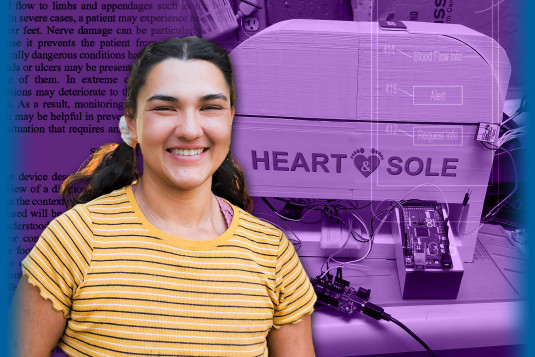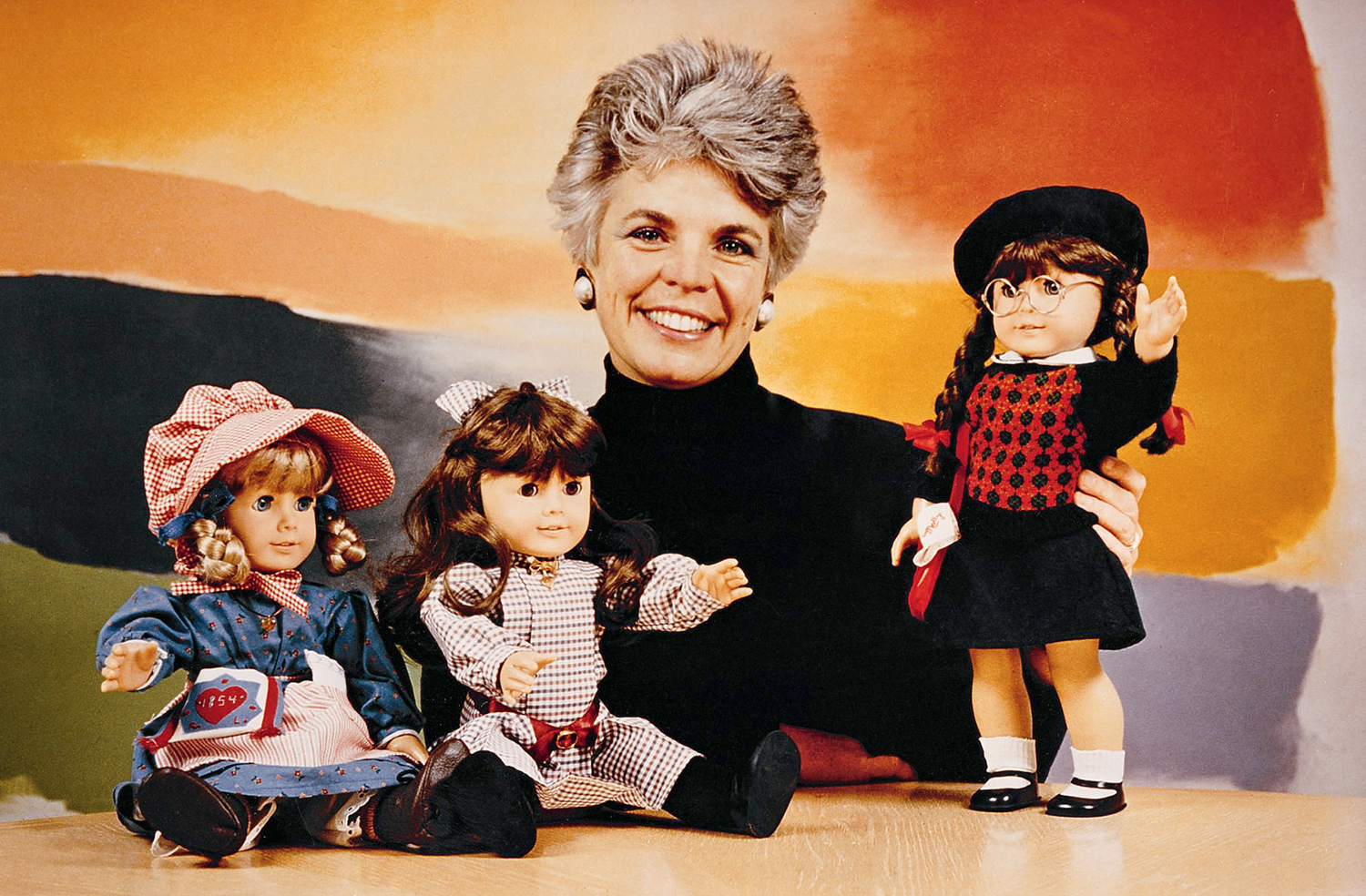
A girl’s window into history
Ignoring conventional wisdom on toys, educator Pleasant Rowland saw a market for tweens and created a beloved $300-million company. With more than 160 million books sold since 1986, the characters Rowland created continue to help children explore American history using stories about 9-year-old girls growing up during challenging times.
23 min read
Each month, our Journeys of Innovation series tells the stories of inventors or entrepreneurs who have made a positive difference in the world. This month, Laura Larrimore's story focuses on Pleasant Rowland, who has inspired generations of children to engage with history when she created the well-known American Girl line of dolls and books over 35 years ago.
Do you know an innovator or entrepreneur with an interesting story?
Pleasant Rowland’s 1984 visit to the meticulously recreated historic park in Williamsburg, Virginia, enchanted her.
“I loved the costumes, the homes, the accessories of everyday life—all of it completely engaged me,” she recalled in a 2002 Fortune Small Business magazine article.
The 45-year-old former teacher and successful textbook author had gone with her husband to a conference in Williamsburg, thinking to take a nice vacation and enjoy the historical exhibits.
“I remember sitting on a bench in the shade, reflecting on what a poor job schools do of teaching history, and how sad it was that more kids couldn't visit this fabulous classroom of living history. Was there some way I could bring history alive for them, the way Williamsburg had for me?” Rowland wondered.
She dashed off a postcard to fellow children’s author Valerie Tripp. Thirty-five years later, Rowland recalled how that postcard held the key idea of what would become The American Girls Collection® brand of dolls.
“It said, ‘What do you think of this idea? A series of books about 9-year-old girls growing up in different times in history, with a doll for each of the characters and historically-inspired clothes and accessories with which girls could play out the stories?’ In essence, I would create a miniature version of the Colonial Williamsburg experience and take it to American girls using the very playthings — books and dolls — that girls have always loved.”
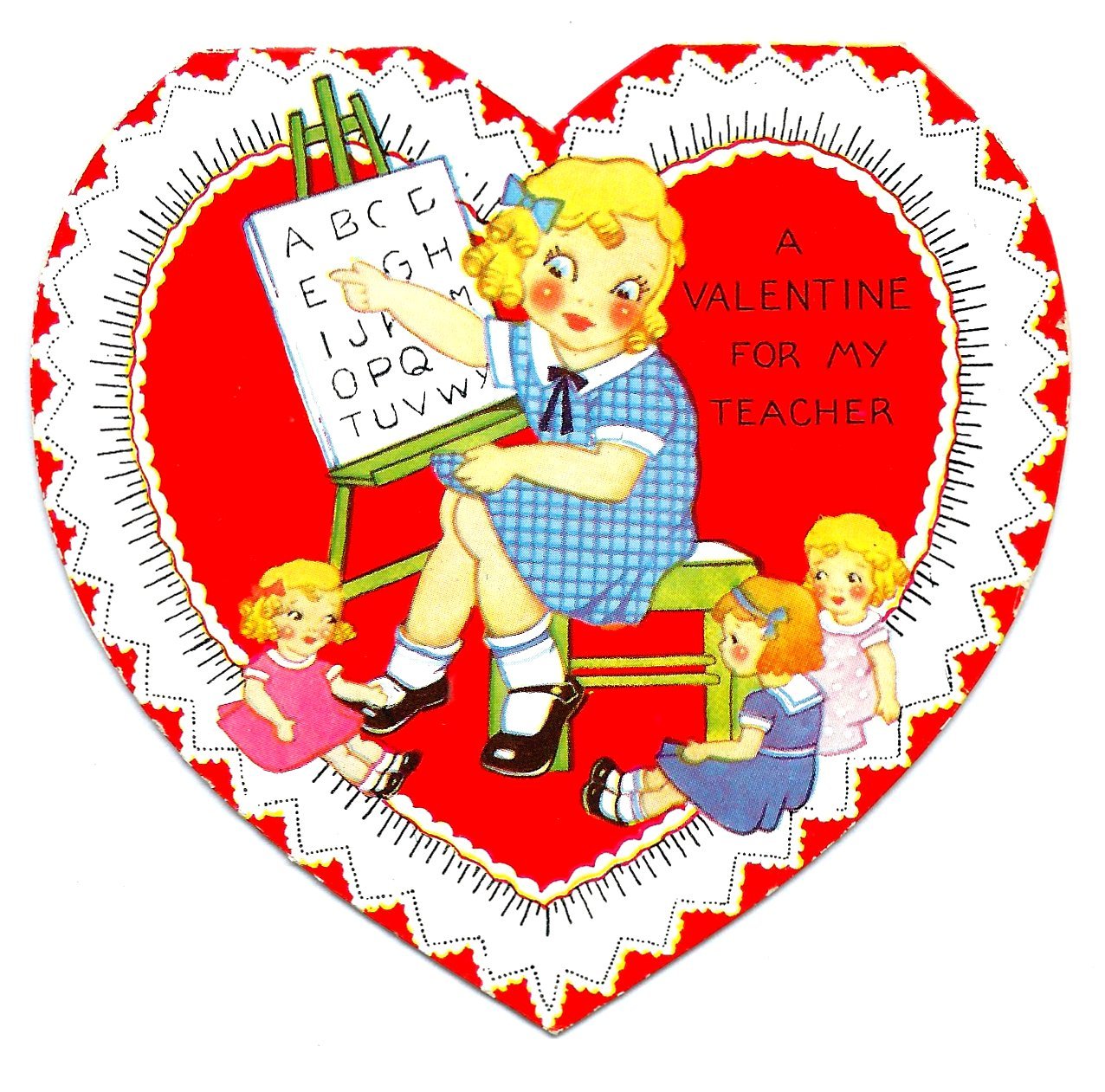
In this vintage Valentine, a young girl pretends to teach the dolls at her feet the letters of the alphabet. Teaching was one of a limited number of professions young girls during Rowland’s youth were encouraged to pursue. (Image courtesy of Joe Haupt)
Nearly 40 years later, it is easy to forget how novel Rowland’s idea was at the time. Few people know that the company Rowland is famous for founding was actually her “third career,” critically informed by her earlier work as a teacher and educator.
Like many young girls in the 1950s, Rowland and her two younger sisters loved playing with dolls in their Chicago-area suburban home. The only thing young Rowland liked better was reading. The Midwesterner brought her love of books to the all-female dorms of Wells College in rural Aurora, New York, where she studied English and hoped to teach young children.
“For as far back as I can remember, a teacher is what I always wanted to be. Perhaps this was not unusual for a girl growing up in the 1950s,” said Rowland. “Back then there were not many careers to aspire to– you could be a nurse, a secretary, or a teacher. Perhaps I chose teacher because it was the only career of the three where you could be in charge, where you could be the boss. My two younger sisters would heartily confirm that I was good at being bossy!”
After graduating from Wells, Rowland began teaching second-grade students at Mattapan Elementary in Massachusetts. Though she had taken to reading easily as a child, Rowland struggled to help her students learn how to read.
“As a newly minted teacher, I, of course, assumed that the books I was given to teach my students to read would do just that–teach them to read. But they didn't. I had students who were struggling and I didn't know why,” she said.
Even teaching practices that had proven effective weren’t exactly fun for the students.
“Phonics, while a reliable and proven foundation, was too often presented as drill and kill, grunt and groan,” Rowland recalled.
So she set out to discover what worked. Through research and experimentation, she constructed what she called her own “cobbled-together” pedagogy to help her pupils.
Those materials eventually turned into a program called Beginning to Read, Write, and Listen, published in 1971 by J. B. Lippincott. Rowland authored dozens of short and colorful alphabet books that are still published by McGraw-Hill.
“It was the first academic kindergarten curriculum ever published and has been in continual use for 40 years,” she shared in a speech to educators in 2011. “Beginning also launched me on my second career as a textbook author. Based on its success, Addison-Wesley, another school publisher, approached me about writing a basal reading and language arts program.”

Pleasant Rowland reads to students during the 1970s from a book she authored as part of the Addison-Wesley Reading program. (Photograph courtesy of American Girl / Zaner-Bloser)
From 1973 to 1978, Rowland developed and oversaw the Addison-Wesley Reading Program, but in 1981 the publishers decided to return the company to its original focus of math and science textbooks.
“The program that I had spent eight years developing was put on the shelf,” she said. In a speech decades later, Rowland recalled it being “one of the most difficult personal disappointments of my life.”
As she considered where to apply her considerable energy and vision next, the trip to Williamsburg became one of two events that propelled her toward her new career as an entrepreneur and famous toy mogul. The second catalyzing event happened that winter, when Rowland was searching for dolls to give her 8- and 10-year-old nieces for Christmas. Surveying the toy shelves full of plastic Barbie® dolls in flashy outfits and the scrunched-faced, yarn-haired Cabbage Patch Kids® popular at the time, Rowland couldn’t find something she wanted to buy – something well-made, something meaningful, and ideally something educational. She saw a hole in the toy market for pre-teens; what if there was a line of high-quality toys and books that inspired girls to learn about history?
But when she met with marketers and manufacturers, Rowland recalled being met with “disbelief and patronizing tolerance, summarized as, ‘Are you kidding? Historical dolls in the day and age of Barbie?’”
Perhaps because as an educator she was more focused on the books than the dolls themselves, the famously detail-oriented author settled on the look of the first dolls without much research. Her doll design was based on a defective, cross-eyed doll, dug out from a dusty back storeroom in a Chicago Marshall Field’s department store by a friend. Undeterred by her lack of toy expertise, Rowland found the manufacturing label sewn into the doll’s underpants, reading, “Gotz Puppenfabrik, Rodental, West Germany” and soon was on a plane to Europe to discuss production.
Rowland’s vision was very clear in her mind.
“In one weekend I wrote out the concept in great detail. I defined the first three characters, the product line, the series of books, the matching girls' clothing, the retail store concept, even the idea for a musical,” she recalled.
Her idea was out of step with what was currently being sold to girls and their mothers. The 18-inch dolls would be sold via mail order catalog, not in toy stores. They would be heirloom pieces and sold at price points to match. They would not be glamorous like Barbie, but instead would have sturdy, childlike bodies and glossy hair girls could style. There would be a line of carefully crafted, historically-inspired accessories and clothes to collect, aligned with each girl’s adventures told in their storybooks. The six books that accompanied the dolls would have beautiful illustrations to bring to life each character and her time period.
As a child, Rowland witnessed her father, a noted Chicago advertising executive, bring home pitch decks for big companies like Pillsbury and Campbell’s.
“Her dad told her great advertising is executed in the details. That’s something she took to heart,” recalled Julie Parks, who worked with Rowland in the early days of her career and has been with the company for more than 26 years. Knowing this, Rowland carefully thought through each detail of the product launch with her team.
“That's what's so exhausting for an entrepreneur,” Rowland recalled later. “If you have a strong vision—and mine was incredibly detailed—you can't let any piece of its execution go. Everything has to be a ten.”
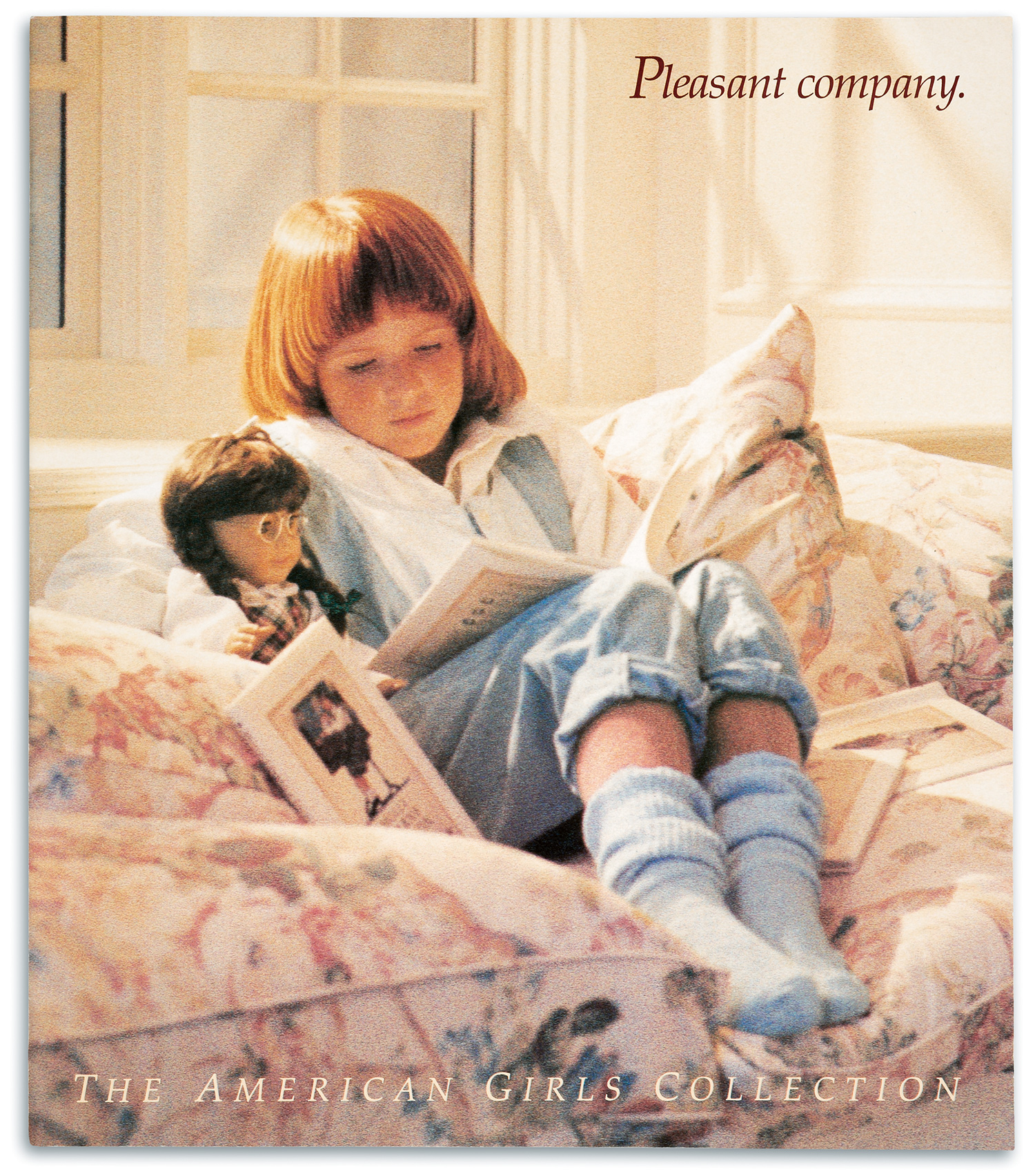
The 1986 Pleasant Company catalog cover, showing a girl reading to a Molly McIntire doll from the newly-launched American Girls Collection. Rowland would submit the catalog to USPTO as part of her trademark application for "Pleasant Company" in October 1986, and later seek trademark registration for "The American Girls Collection" as well. (Image courtesy of American Girl)
Time periods were researched and carefully selected, book drafts were written and illustrations drawn, and the three dolls, their tiny accessories, and their accompanying advertising were developed for the initial launch. The company’s first dolls would be Samantha Parkington, a mischievous orphan growing up in 1904; Kirsten Larson, a hard-working pioneer and Swedish immigrant from 1854; and Molly McIntire, a spunky girl living through World War II in 1944.
The whole concept seemed farfetched to mainstream retailers. The doll’s price of $80 was too high, staff at Lands’ End told Rowland, believing their customers wouldn’t pay more than $40 for a doll. Toy makers scoffed at selling dolls to 9- to 12-year-old girls, as they believed girls stopped being interested in dolls around 6 years of age. Even the list management company Rowland hired to send out her mail-order catalogs told her to scale down her ambition; send only 100,000 catalogs, they told her, not the 500,000 she planned.
“I said, ‘No way,’” Rowland recalled. “We had to take our shot that Christmas, and American Girl would either succeed or fail. So we mailed 500,000 catalogs and crossed our fingers.”
By the fall of 1986, Rowland had sunk nearly all the money she had earned from her textbook royalties into the venture – well over $1 million. She had ordered half a million catalogs printed, and even submitted a trademark application to protect her new brand. Sitting in a broken-down warehouse with one freight elevator in downtown Madison, Wisconsin, Rowland and the staff at Pleasant Co. waited anxiously for the phones to ring with orders.
The gamble paid off. Between September and December 1986, American Girl sold $1.7 million worth of product. The phones rang incessantly and the workers had to cobble together extra packing stations from plywood and old doors, wearing mittens when the heat in the building periodically cut out. The second year the company did even better, with $7.6 million in product. And sales continued to rise year after year. The toys were a hit, and Rowland had proven that what she wanted for her nieces was something other American girls wanted too.
“For all the money the company made subsequently,” Rowland told Fortune Small Business, “none of it was as fun or rewarding as that first million dollars.”
Still, the money allowed Pleasant Company to expand and move to a brand-new space 10 minutes outside of Madison. Rowland remained focused on the fledgling enterprise, despite being diagnosed with breast cancer in the company’s third year.
“I cut the ribbon on the new warehouse in the morning and went into the hospital that afternoon to have surgery,” she recalled. “It was a large tumor, and I had a poor prognosis, but throughout chemotherapy and radiation I never missed a day of work, and work is probably what saved me. Pleasant Company was on such a roll. I loved what I was doing, and after all my mind didn't have cancer. I just got through.”
Thus, bringing to market The American Girls Collection® (the trademarked brand name of the six original dolls created by the Pleasant Company®) was the start of Pleasant Rowland’s “third career.”
“I dedicated my third career to teaching American history to young girls through books, dolls, and related playthings,” she said. “Never in my wildest dreams did I imagine American Girl would become the huge success it did, redefining the world of books and play for young girls, an audience that had been underserved until then.”
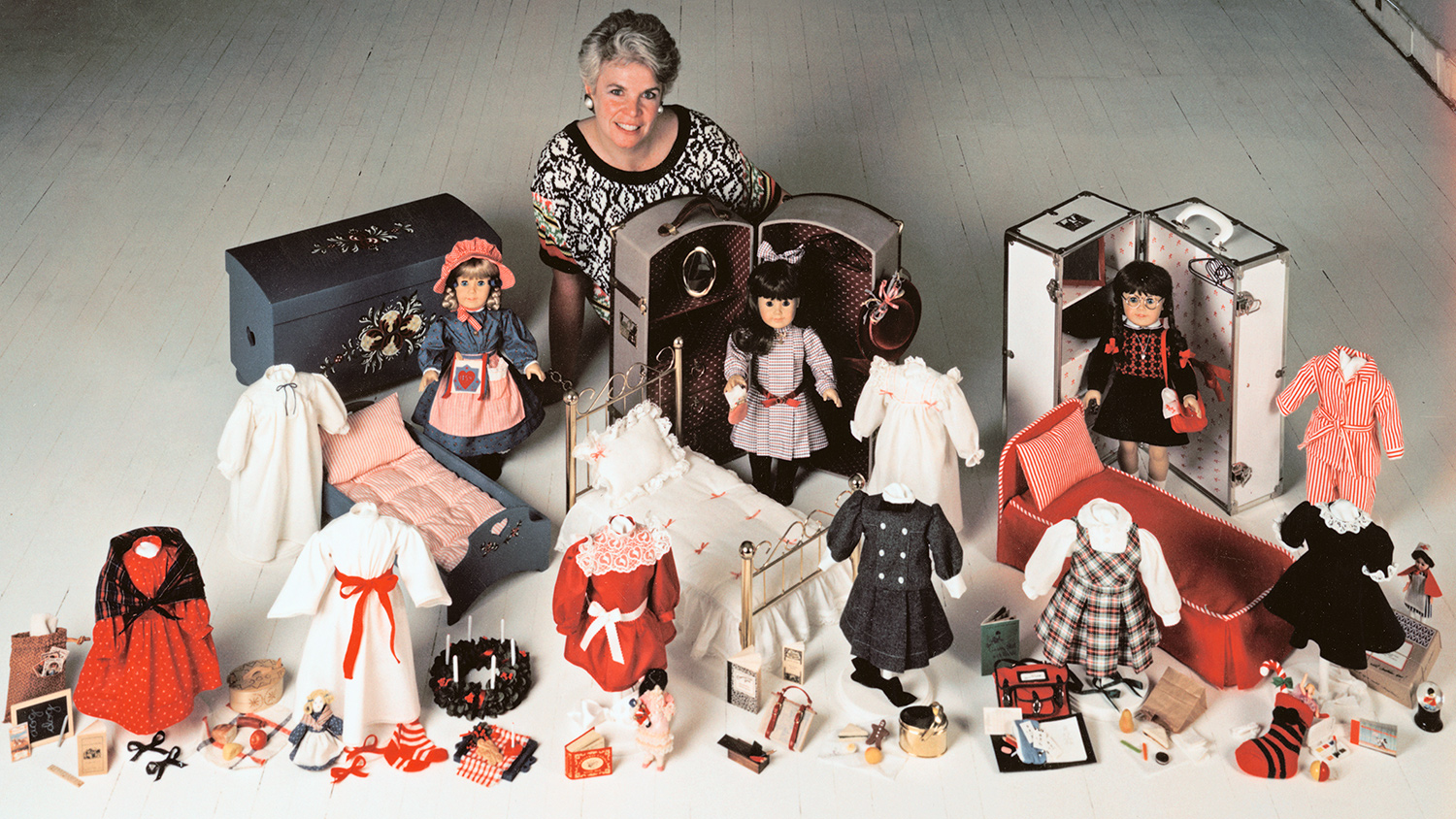
Pleasant Rowland poses alongside the three original dolls and their clothes and accessories. Left to right: Kirsten, Samantha, Molly. (Photograph courtesy of American Girl)
Rowland’s concept was perfectly positioned to appeal to parents in the late 1980s. The dolls triggered nostalgia for supposedly simpler times, and the books’ wholesome stories and accessories inspired little girls to reenact a variety of activities shown in the books, like having tea, writing on a school slate, or playing with their own tiny dolls.
Yet alongside the detailed illustrations of ruffled dresses and hairbows, the stories revealed a past that was anything but simple. Through imagination and play, girls experienced challenges, struggles, and progressive changes throughout American history alongside their historical counterparts. Each fictional 9-year-old, using individual personality traits like intelligence, bravery, and resourcefulness, engaged actively in the changing historical times around her. Nearly every detail in the books was intentional.
"We knew that we wanted Samantha to have lived at the turn of the last century,” recalled book author Tripp, “because we felt that that was an enormous turning point for women."

Rowland signed and numbered this Samantha doll #1 in her own hand. In July 2021, all six of the original dolls signed #1 by Rowland were auctioned by PBA Galleries. The Samantha doll sold for $14,000, nearly twice the pre-auction estimate and an indicator of the American Girl dolls' popularity and historical significance. (Photograph courtesy of Maurice Johnson/PBA Galleries)
Indeed, a key story arc for wealthy and sheltered Samantha hinges upon the conflict she feels after writing a pro-manufacturing essay that wins a contest, only to later learn her poorer friend Nellie’s siblings are experiencing brutal conditions working in a factory. This small peek into the labor issues at the turn of the century ultimately drives Samantha to give a speech against child labor at the awards ceremony for her essay, likely before the same adults who thought nothing of employing children to work in their factories. The Atlantic magazine called the storyline “a bravura effort at teaching young girls about class privilege, speaking truth to power, and engaging with controversial social policy, all based on empathetic encounters with people whose life experiences differ from her own.”
In this deceptively straightforward way, the books taught readers to engage with history and empowered girls to think critically about history and others’ experiences. Rowland would call it “chocolate with vitamins” and describe the dolls and books as “windows and mirrors” for young girls. A doll could be a mirror, allowing a girl to bond with the character over commonalities like similar appearance, personality traits, or challenges at school. But a character might also be a “window” for a little girl, allowing her to consider experiences or cultures she had no personal experience with, much like wealthy Samantha’s growing awareness of Nellie’s brothers and sisters at work in the factory.
After the smashing success of the first three dolls, new dolls followed, each with carefully researched backstories set in different eras and towns in American history. Felicity Merriman, a girl who loves horses and lives through the American Revolution, was released in 1991. For over a year, Rowland consulted with staff members who worked at Colonial Williamsburg to create clothes, hats, and accessories like a tea table and tea chest.
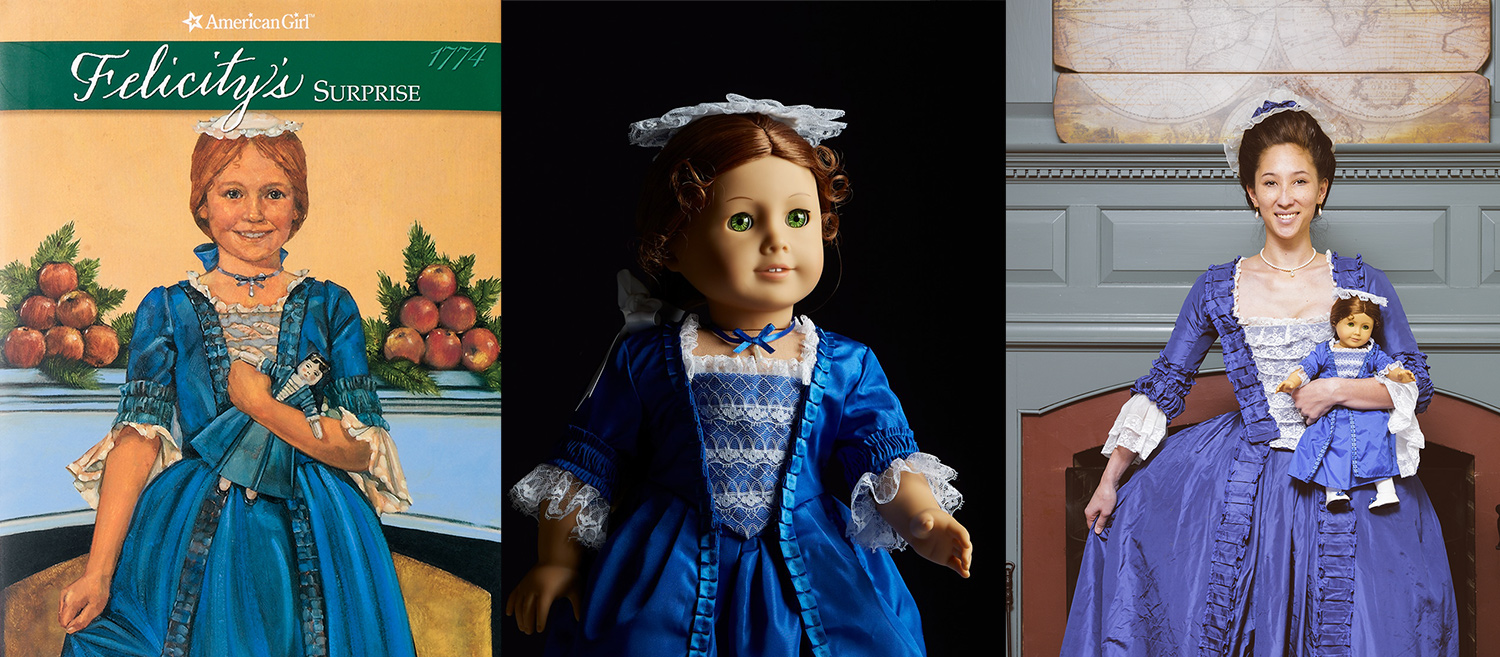
Felicity Merriman, a girl growing up during the American Revolution in Williamsburg, was designed with input from employees at Colonial Williamsburg. The Felicity doll (middle) wears a ballgown that appears on the cover of her storybook that describes a winter ball (left). While the Pleasant Company sold child-sized outfits to match, in 2016 dress historian Samantha Bullat created an adult-sized costume she wore to Williamsburg in order to recreate the iconic cover art of the book (right). (Images at right and center courtesy of American Girl, image at left courtesy of The Colonial Williamsburg Foundation)
In her books, feisty, red-haired Felicity roams the houses, fields, and streets of Williamsburg having various adventures, like freeing a mistreated horse, attending the Governor’s Ball, and actively helping the Revolution, a full-circle moment for Rowland’s initial vision of a child-size Williamsburg experience. In addition to Rowland’s friend Valerie Tripp, who authored several of the initial books, Rowland sought out other talented writers and illustrators to work on the series. Many mined their own experiences and families for inspiration and authenticity. “Felicity’s younger sister and brother were my kids,” recalled Dan Andreasen, who illustrated some of the earlier books. “When I did the [later] Samantha books, I used my daughter as the model for Samantha and her best friend for Nellie.”
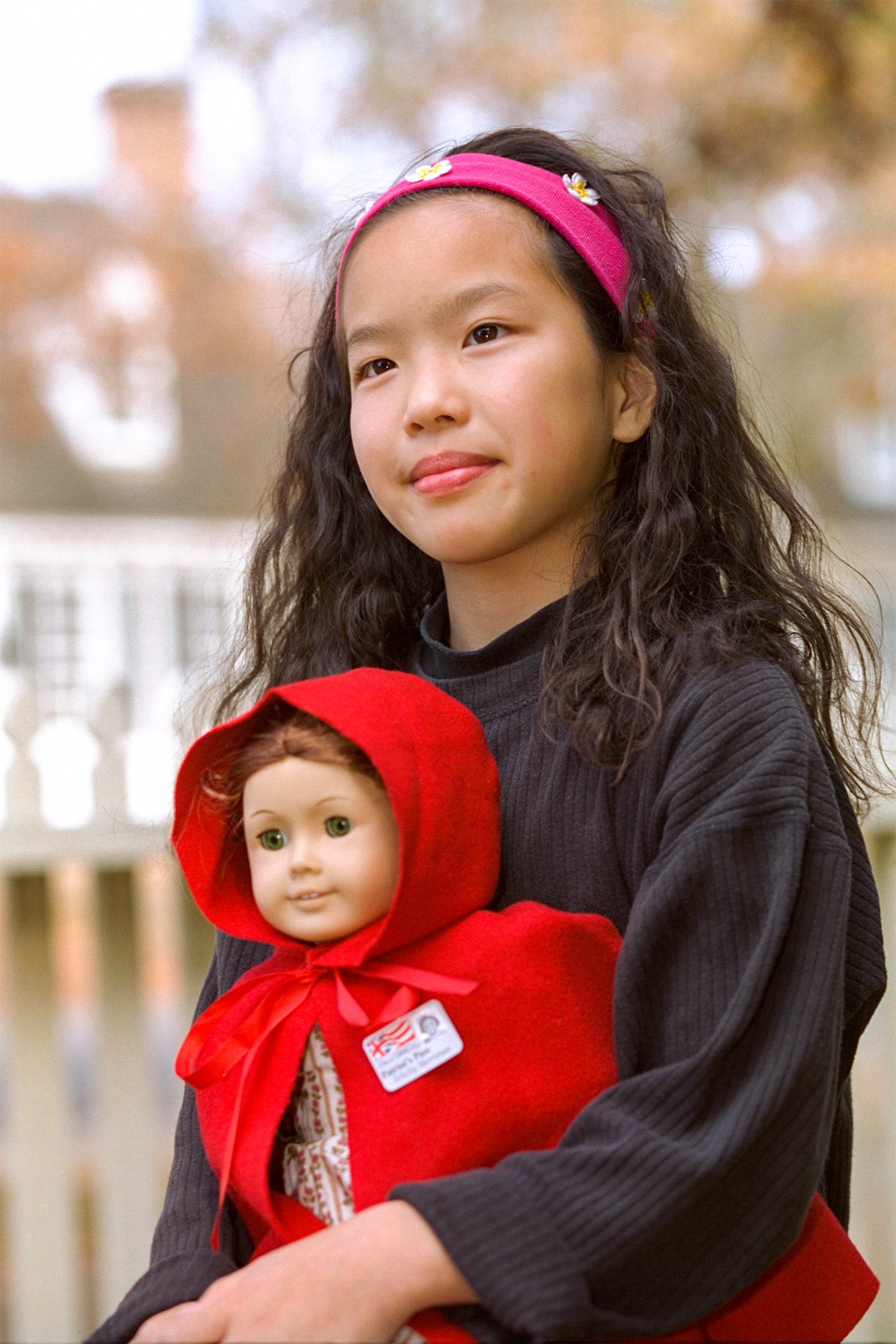
A girl carries her Felicity doll while visiting Williamsburg. Colonial Williamsburg eventually created a miniaturized visitor badge to give children for their dolls as shown here. (Photograph courtesy of The Colonial Williamsburg Foundation)
By 1991, sales had reached $50 million, and the company began preparing for the launch of the its first non-white historical doll, named Addy Walker. Addy was African American, and like the previous dolls and their books, required years of research and work by the company before Rowland was ready to release the new character. As the head of a Wisconsin-based company with predominantly white employees, Rowland took the important step of assembling an advisory board of historians, educators, and museum directors to help develop Addy. Like Connie Porter, the author chosen to write Addy’s books, the members of the advisory board were both experts in their respective fields and Black themselves. Board member Lonnie Bunch would go on to lead the Smithsonian’s National Museum of African American History and Culture. Porter reminisced to the Los Angeles Times in 1994 that Pleasant called her out of the blue to write the books, even though Porter was a novelist and college professor, and had never written for children.
“I was not at all familiar with American Girl,” Porter told Slate reporter Aisha Harris years later.
But through persuasive persistence, Rowland convinced Porter to join the team and the advisory board.
The time period that Addy would inhabit was fiercely debated. With its rich Black culture, 1920s Harlem was considered. But after much discussion, the team decided that Addy’s story should start in the south in 1864, as Addy and her mother plan an escape from slavery. The books followed them as they travel north to create a new life for themselves.
Despite some company-imposed limitations, such as this pre-selected time period and basic plot, “I liked the approach to history that they were taking,” Porter said.
The plotline allowed children to see an African American family in the waning days of slavery and follow the family to freedom in Philadelphia. The Los Angeles Times called it “an intriguing way to make a painful slice of the past come alive for young people.”
Showing children a relatable story of a 9-year-old girl who was enslaved was highly unusual.
“When I was growing up, there were no books with African Americans in them, never mind books about the slave experience,” Porter recalled.
A few years after Addy debuted, Porter would tell the Ocala Star-Banner that she saw the books as teaching tools: “I want children to see African American people as part of strong, loving families, caught up in slavery, doing what they had to do to survive. I want them to realize Addy is part of a group of people. There were a million Addys out there. They lived and died.”
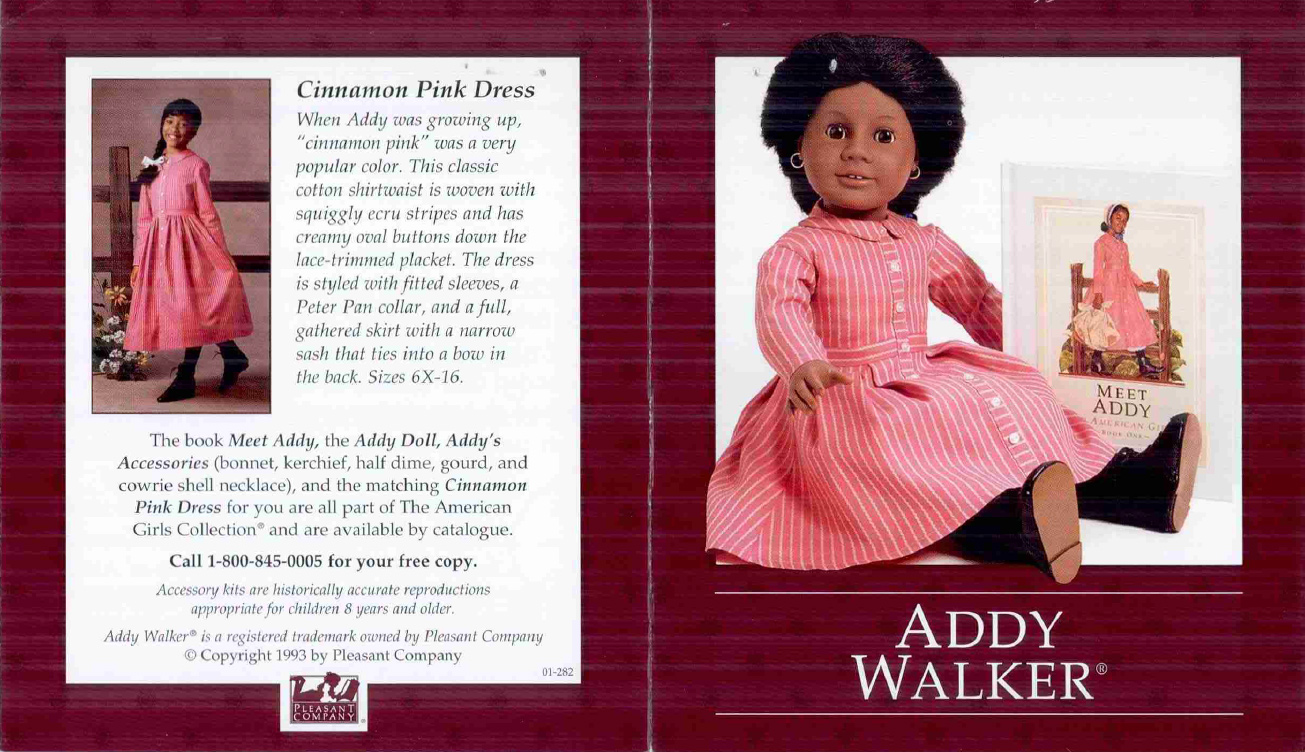
The Addy Walker doll booklet, submitted to the USPTO as part of the trademark registration process included information about the doll, her book, and her accessories including a cowrie shell necklace. To protect the brand, individual doll names including Addy Walker® were trademarked, and the six historical dolls were marketed collectively under The American Girls Collection® trademark.
Despite the usual complaint about the high price point of the doll, and a minor quibble that the plot conveniently made Addy’s enslaved mother a dressmaker in order to give historical plausibility to Addy's nicer clothes and accessories, her series was a success. Porter told the Los Angeles Times that the testimonials of 7- to 12-year-old girls — her reading constituency — are what most persuaded her the books hit the mark.
Slate reporter Aisha Harris recalled receiving her Addy doll at the age of 5 in 1993.
“Though the books were probably not my first lesson about slavery, they’re the first I can remember,” Harris wrote in a nuanced Slate article describing the creation process and significance of Addy to many girls growing up at the time.
Indeed, most historians and educators then and since have praised the American Girl book series for their positive messages and ability to engage children in considering difficult history in age-appropriate ways.
“The stories from history are about strong girls facing crises like slavery and the Depression in strong ways,” says Mary Ann McGrath, professor of marketing at Loyola University.

Rowland speaks at the 25th anniversary celebration of American Girl. (Photograph courtesy of American Girl)
Building on the success of the original six historical character dolls, Rowland branched out. The Pleasant Company released the Bitty Baby® dolls and books, a line aimed at younger girls, and a line of products for older girls, including the American Girl of Today® modern dolls, with both new product lines becoming registered trademarks in 1996. The company also launched American Girl magazine, and a line of advice books that touched on topics such as friendships and dealing with difficult social situations.
"From its beginning vision, it was a company that was bigger than the sum of all those parts. It was a girl company, and anything that was good for girls was ours to give them," Rowland told a crowd gathered for the 25th anniversary of the company.
The look-alike modern doll line, initially called American Girl of Today®, then later “Just Like You” and finally “Truly Me,” debuted in 1995. “She’s just like you,” the catalog read. “You’re a part of history too!”
It gave girls the clearest “mirror” of themselves yet. Girls could select their doll’s eye color and hair color to match their own, and eventually, girls who might not have hair due to medical conditions could even select bald-headed dolls. As with the historical dolls, there was an ocean of outfits and accessories related to hobbies, school activities, and other elements of a 9-year-old’s life.
“You can buy your doll orthodontic headgear; there are allergy bracelets and EpiPens, wheelchairs and service dogs,” marveled a journalist who visited the American Girl flagship store. “Anything that may make a girl different is treated as entirely standard here.”
But while girls and their caregivers continued to ensure American Girl’s profitability year after year, some women lamented the decreased focus on the historic dolls, which gave girls a window to navigate a miniature version of history.
“Limiting the range of their canonical adventures to the present-day, first-world problems of these little girls who are Just Like You is a big mistake,” wrote Washington Post columnist Alexandra Petri. “Sure, maybe you picked your first American Girl doll because she resembled you… but the whole point was to give you an entry point to history. Felicity or Samantha or Addy reminded you that, during the Civil War and the Revolutionary War and all the fascinating important times of history, there were Girls Almost But Not Quite Like You. You could see yourself in history! You could engage with the biggest moments of the past!”
By 1998, Rowland had been running the company for over a decade. She had led several product expansions, opened the flagship American Girl Place store in Chicago, and even created a musical based on the historical characters’ adventures, called American Girl Review. Everything she had dreamed up that one weekend, she had fully realized. The original line of six historical dolls was wrapping up with the release of Josefina Montoya, a girl whose story offered a window into colonial-era Mexican and Spanish culture in 1824 near Santa Fe, which would eventually become the state of New Mexico.
“Finally my vision was complete, my original business plan had been executed, and I was tired,” Rowland wrote. “It was time to sell the company.”
She would select major toy maker Mattel, because she liked and trusted the then-CEO, Jill Barand.
"I stopped and looked around at all I had built, expecting to be overwhelmed by sadness or loss. But no emotion came. I drove home thinking, What's wrong? Why don't I feel anything?"
Mattel purchased American Girl for $700 million, allowing Rowland to step back from her third career as a toy mogul. After signing the papers, Rowland wasn’t sure how she would feel.
Preparing to leave the building for the day, she recalled: “I stopped and looked around at all I had built, expecting to be overwhelmed by sadness or loss. But no emotion came. I drove home thinking, What's wrong? Why don't I feel anything? It was then I realized that I had never felt I 'owned' American Girl. I had been its steward, and I had given it my very best during the prime of my career. It was time for someone else to take care of it. American Girl was a wonderful chapter in my life that is now closed. And on we go."
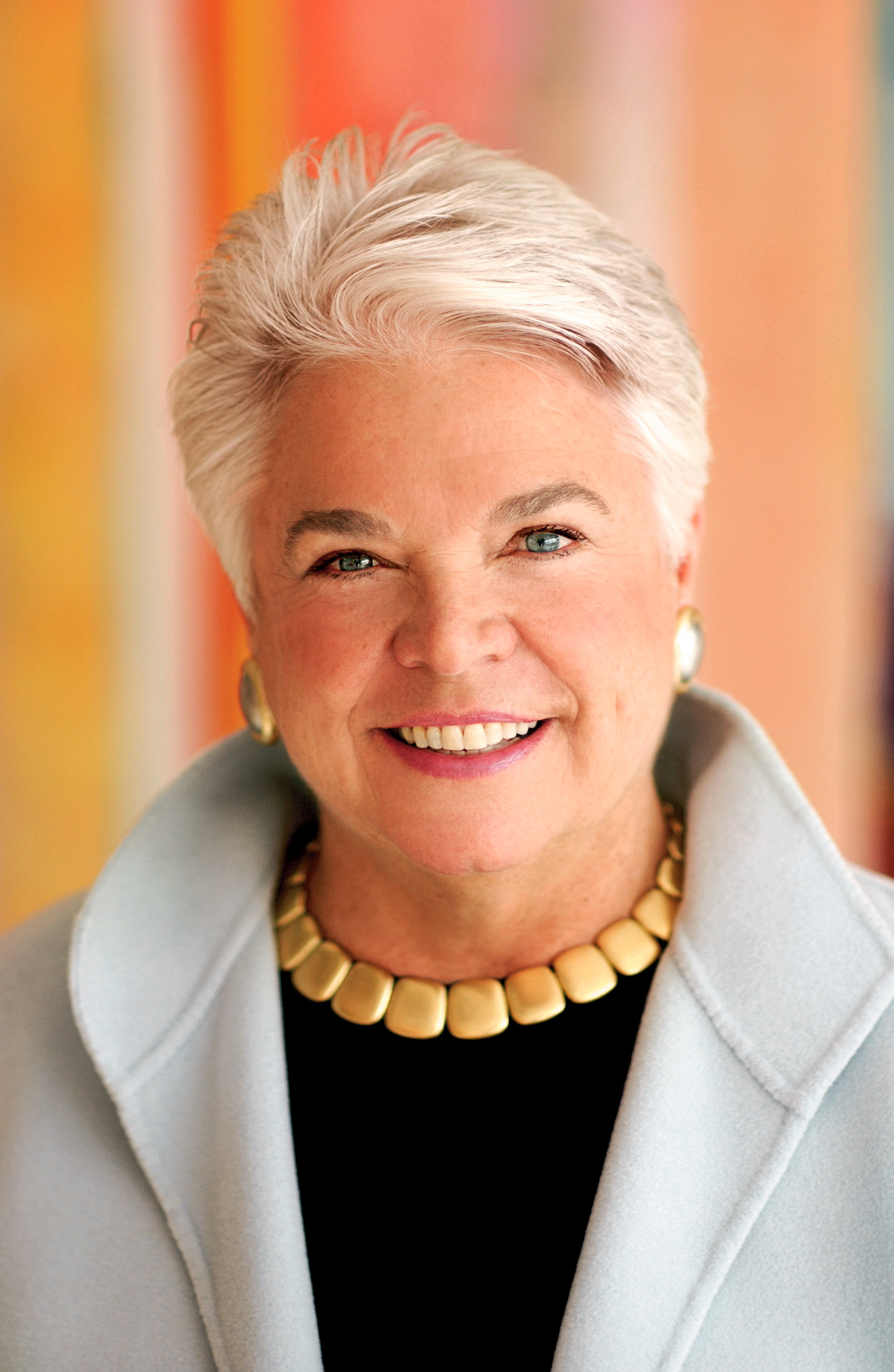
Pleasant Rowland in a recent headshot.
The sale of the company and its various publishing endeavors made Rowland wealthier than beloved American writers Louisa May Alcott, Mark Twain, Harper Lee, and Dr. Seuss combined. But while the media tended to focus on the dolls, since 1986 the company has sold over 160 million books, outpacing the 36 million dolls sold by three to one. With many books ending up in schools and public libraries, the stories of plucky 9-year-old girls throughout American history have reached hundreds of millions of children.
The next 25 years could be considered Rowland’s fourth, fifth or perhaps sixth career. She and her husband established several foundations and began giving generously to community non-profits, often anonymously. To this day she focuses her philanthropy on causes that interest her in the arts, education, and historic preservation, including helping to fund the Centro Hispano of Dane County and the Black Business Hub in Madison.
“From my own experience, I understand the power of an entrepreneurial vision to impact families and communities for generations,” Rowland said.
Even today, Rowland’s American Girls continue to help girls and women understand their role within history. At the start of the COVID-19 pandemic, as children quarantined at home, libraries moved story time online and helped a new generation discover stories like those of plucky American Girl Molly McIntire, who grew up in the midst of World War II and persevered through wartime sacrifices and disappointments. The historical perspective comforted children and helped them consider the unique moment in history they were living through and what lessons they might learn from it.
In 2022, there was a flood of memes that placed American Girl dolls in modern contexts, with the hashtag #AmericanGirlDoll garnering 315 million views on TikTok. As women who grew up in the 1990s with American Girl dolls struggled to process the realities of today, including the pandemic and the 2022 Supreme Court decision that overturned Roe v. Wade, some turned to the intrepid heroines of childhood. “We need an American Girl doll who….” became a popular social media meme, featuring the dolls in various modern scenarios. (Example: “We need an American girl doll who eats cheese out of the bag with her hand.”)
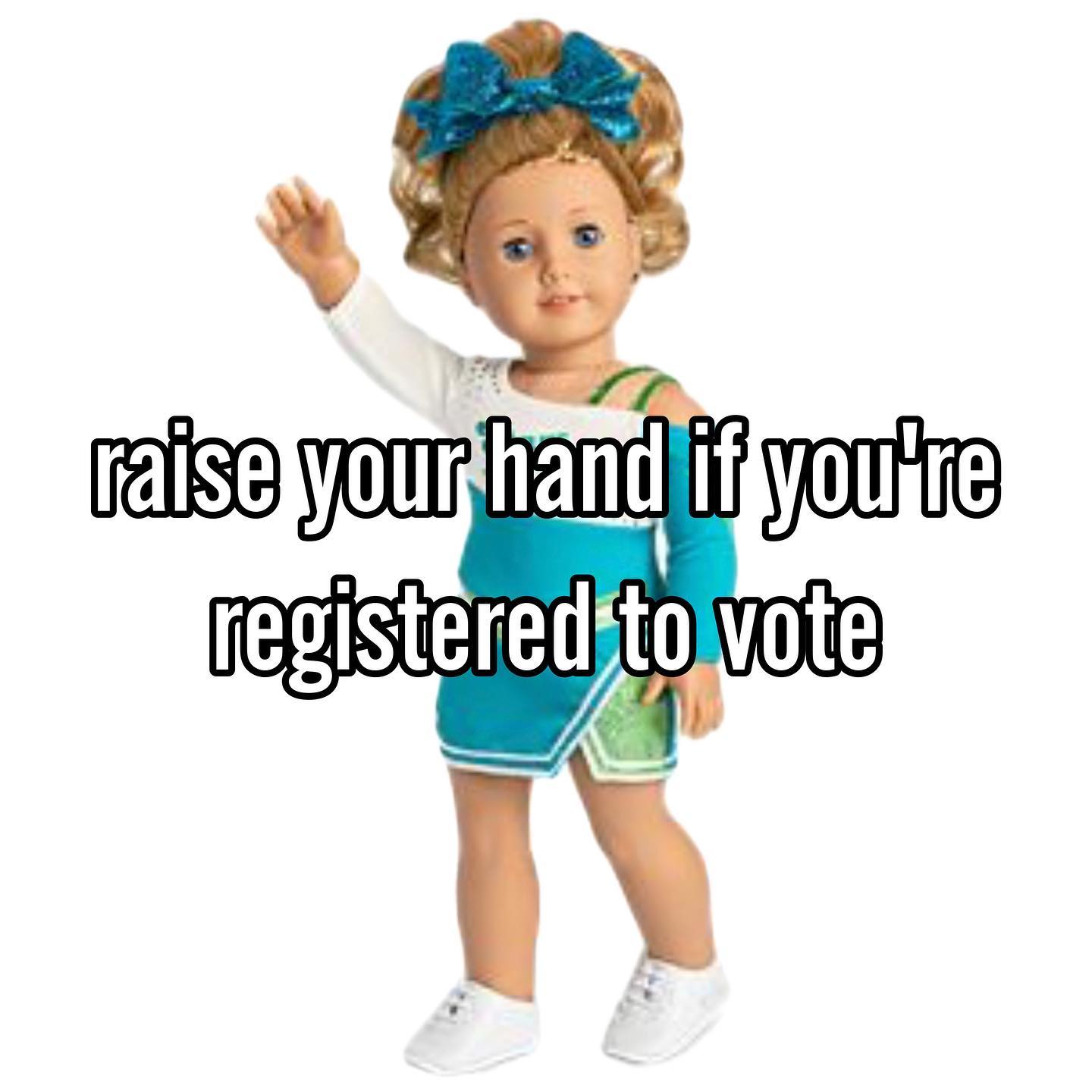
A contemporary meme featuring an American Girl doll. (Image courtesy of Barrett Adair)
"It's cute that when we were girls, we found the dolls relatable and even empowering, and now that we're adults, we can turn them into memes about life in 2022 and still find them relatable and empowering," Barrett Adair, a social media content creator, told InStyle magazine.
Even 40 years later, Rowland’s vision to educate children and help tweens understand history remains relevant as a way to understand and engage with our past and present.
Credits
Produced by the USPTO’s Office of the Chief Communications Officer. For feedback or questions, please contact inventorstories@uspto.gov.
Story by Laura Larrimore. Additional contributions from Axel Alfaro and Rebekah Oakes. Special thanks to Whitney Pandil-Eaton, Julie Parks, Maurice Johnson, Zaner-Bloser, The Colonial Williamsburg Foundation and American Girl.
Catalog photo on the USPTO homepage and images of Pleasant Rowland courtesy of American Girl. All other uncredited image from the USPTO Trademark Status and Document Retrieval system (TSDR).
References
American Girl. “The Beginning of Forever,” YouTube video, 2:36, May 15, 2014, https://youtu.be/fAhd7-p0eDs.
American Girl. “Pleasant Rowland speaks at American Girl 25th Anniversary Tribute,” YouTube video, 20:22, November 29, 2011, https://youtu.be/_ltX5W6eZYw.
Dahmer, David. “Centro Hispano Awarded $1M from Pleasant T. Rowland Foundation to Build New Facility,” Madison365.com, September 20, 2022. https://madison365.com/centro-hispano-awarded-1m-from-pleasant-t-rowland-foundation-to-build-new-facility/.
Dunn, J.A. “Addy is More Than a Character for Connie Porter.” Ocala Star-Banner, October 18, 1996. https://news.google.com/newspapers?id=vc9PAAAAIBAJ&sjid=fwcEAAAAIBAJ&pg=2280%2C1079184.
Gibson, Liesl. Interview with Dan Andreasen, the Oliver + S paper doll illustrator. https://oliverands.com/community/blog/2008/09/interview-with-dan-andreasen-oliver-s.html.
Harris, Aisha. “The Making of an American Girl.” Slate, September 21, 2016. https://slate.com/culture/2016/09/the-making-of-addy-walker-american-girls-first-black-doll.html.
Mehren, Elizabeth. “Writer Brings Painful Past to Life.” Los Angeles Times, Nov. 28, 1994.
PBA Galleries. “35 Years of American Girl dolls, a conversation with AG’s Julie Parks,” Youtube Video, 39:50, June 22, 2021, https://youtu.be/P3GZ1YbTX8g.
Rubin, Julia. “All Dolled Up: The Enduring Triumph of the American Girl.” Racked, Jun. 29, 2015. https://www.racked.com/2015/6/29/8855683/american-girl-doll-store.
Petri, Alexandra. “Even More Terrible Things are Happening to the American Girl Doll Brand Than You Thought.” The Washington Post, May 1, 2013. https://www.washingtonpost.com/blogs/compost/wp/2013/05/01/even-more-terrible-things-are-happening-to-the-american-girl-doll-brand-than-you-thought/.
Urban League of Greater Madison, “Urban League of Greater Madison: Pleasant T. Rowland Foundation Announces $1,000,000 Gift to Help Transform Black Entrepreneurism for Generations to Come.” Press release, November 23, 2021. https://www.wispolitics.com/2021/urban-league-of-greater-madison-pleasant-t-rowland-foundation-announces-1000000-gift-to-help-transform-black-entrepreneurism-for-generations-to-come.
Poggi, Maria Santa. “We Need an American Girl Who Will Save Us,” InStyle, July 19, 2022. https://www.instyle.com/reviews-coverage/american-girl-doll-memes.
Rowland, Pleasant, and Julie Sloan. “A New Twist on Timeless Toys,” October 1, 2002, Fortune Small Business.
Rowland, Pleasant. “Teaching All Children to Read: The Challenge of Our Times” (Keynote address at IDA Reading, Literacy, and Learning Conference. Chicago, Illinois, November 9, 2011.) https://www.thereadingleague.org/wp-content/uploads/2018/09/Teaching-All-Children-to-Read_-The-Challenge-of-Our-Times-Rowland.pdf.
Safronova, Valeriya. “American Girl doll jokes are all the rage,” The New York Time, June 23, 2022, updated July 13, 2022. https://www.nytimes.com/2022/06/23/style/american-girl-memes.html.
Schiller, Amy. “American Girls aren’t radical anymore,” The Atlantic. April 13, 2013. https://www.theatlantic.com/sexes/archive/2013/04/american-girls-arent-radical-anymore/275199/.



